Expert Speaks on Gender-Based Violence and Forced Marriage
Expert Kasumi Nakagawa provided insights about forced and arranged marriages under the Khmer Rouge, as well as gender-based violence. She said that although many people volunteered to get married, part of them did so because of a general feeling of terror. Others were forced to marry. She also spoke about the pressure to consume the marriage and the negative emotional, sometimes traumatic, impact this had on both men and women.
Oral Submissions
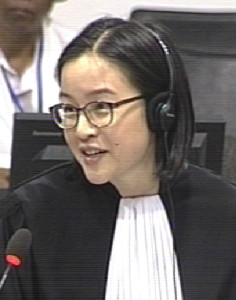
Nuon Chea Defense Counsel Doreen Chen
At the beginning of the day, oral submissions and observations regarding two requests were heard. First, the Nuon Chea Defense Team was asked to respond to a request by the Co-Prosecution to admit nine documents.[1] Nuon Chea Defense Counsel Doreen Chen pointed out that the documents were available in November 2013, November 2014, October 2015, and March 2016 and that the Co-Prosecution had pointed out that two of them contained potentially exculpatory information. Moreover, no justification for disclosure for two documents were given. She then highlighted that two documents were authorized for disclosure in December 2015 but only requested for disclosure now, which she said was a violation of the prosecution’s obligation to disclose exculpatory documents as soon as possible. She then said that the report was from the same NGO that had produced earlier reports and that the expert worked for. Ms. Chen then said that the Co-Prosecution had heavily criticized the Nuon Chea Defense Team for an allegedly late request to admit documents. “Frankly speaking, that’s the pot calling the kettle black here”, she said.
The Khieu Samphan Defense Team supported the Nuon Chea Defense Team’s position and said that they did not understand why this request was so late. They had requested disclosure of a document that the prosecutors were already referring to earlier and had therefore known of.[2] The Civil Party Lead Co-Lawyers did not have any observations.
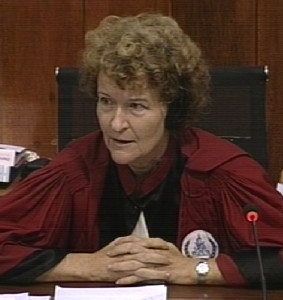
Judge Claudia Fenz
Deputy Co-Prosecutor William Smith responded to the observations by saying that the authorization for disclosure for most of the documents was granted on August 31 of this year. He explained that four documents (6-9) were statements of witnesses who stated that they were not forcibly married. He put forward that none of the four reports would make a difference in the cross-examination. As for the two documents for which no reasons for disclosure was indicated, he explained that they were documents from proposed witnesses. He also explained that they had not requested disclosure of these documents earlier, because the Defense Team had complained that they were “being bombarded with information.” He pointed to decision E363, in which the Trial Chamber had urged the prosecution to focus on disclosures of exculpatory information. The prosecution had decided that if they put forward surveys, the underlying statements should also be put forward. Lastly, he reiterated that the Nuon Chea Defense Team had requested 2,200 documents to be admitted in a very short time frame.
Judge Claudia Fenz took the stance and explained that it took them 48 hours between disclosure and giving the relevant information to the parties. To request disclosure of documents at 4 pm on the day before the testimony of the expert was “clearly not helpful, to put it mildly”.
Mr. Smith explained that four people saying that they were not forcibly married was not directly exculpatory and therefore did not change the strategy.
Ms. Chen said that this did not answer the question as to why they were only disclosed now and not as soon as disclosure was permitted.
The presiding judge Ya Sokhan closed the discussion on this topic and then called for submissions on the request to admit a map. The Nuon Chea Defense Team did not object to admitting this document, but asked why this request had not come earlier.

Khieu Samphan Defense Counsel Anta Guissé
Khieu Samphan Defense Counsel Anta Guissé pointed out that the prosecutors themselves had annotated the map. They would object admitting this document if the annotations indeed came from the prosecution. Mr. Smith explained that the annotations did not have to be admitted, but that they requested the core map to be admitted. The Civil Party Lead Co-Lawyers had no observations.
Expert: Kasumi Nakagawa
The president ordered to usher in the expert. Ms. Kasumi Nakagawa was born on June 11, 1972. She currently is a teacher at Pannasastra University in Phnom Penh. She completed her academic background in Japan. She started her university degree in 1991 and finished it in 1995. Her studies focused on Pol Pot and on the question how he was able to take power from a political science perspective and an international relations perspective. She commenced her master’s degree in 1996 and completed it in 2000 at Osaka University. She came to Cambodia as a tourist for the first time in 1995. Next, she moved to Cambodia for work in 1997 as a special assistance to the Japanese Embassy for two years until March 1999. She fluently speaks Khmer, but does not write it well.
Research
She had conducted research on gender and women in Cambodia, worked with the UN, national and international NGOs, and the Ministry of Women’s Affairs for the Cambodian government. She conducted grassroot research, but also engaged in policy formulation. Her first work on forced marriage was conducted in 2006 with the Cambodian Defenders Project. She was the project manager to carry out a study on sexual violence/gender based violence. In 2008, she conducted research on the same topic, but in particular on forced marriage together with 200 students (at Pannasastra University). In 2014, she researched on gender based violence against sexual minorities. In 2015 she published her work Motherhood at War, which examined the topic of pregnancy during the Khmer Rouge time, marriage and rape. Her most recent work is about childhood at war and looks at the life of children during the Khmer Rouge time, posing the question how children were denied childhood, as well as forced marriages of small girls. Asked about her motivation to conduct all this research, she said that “I simply want to know why it happened”. She explained that there was much conflicting information during her studies at the university, and she did not understand why so many people died during the Khmer Rouge regime. “I was particularly interested how women were affected by the war, how women were disproportionally affected by the regime”. However, she could not find any studies on this. “So I thought I could contribute by gathering the information and evidence of why it happened particularly from women’s point of views. Because so far we don’t have any historical evidence”. All evidence that was collected was written by men. “It was very very painful research for me personally”, she said, since she listened to the “horrendous stories” many times. Her first publication was published in Japanese.
“I knew that there was rape, so rape was one of my primary targets for my research”. Through this, she came across other forms of gender-based violence.
As for the research methodology of her first publication, she said that they recruited 50 volunteers from five provinces. Ten of these attended an intensive two-days training for researchers. Following this, they trained the remaining 40 volunteers. Subsequently they collected accounts of 1,500 people. Of these, they screened who could tell the stories and selected around 100 people who they thought they should meet. They let the fill out questionnaires, including questions such as: “Did you witness sexual violence? Did you experience any sexual violence?”
She and another researcher then talked to the selected people in different regions. Ms. Nakagawi herself met approximately 50 people. They tape-recorded all conversations, following which a person made the transcript that was then translated into English.
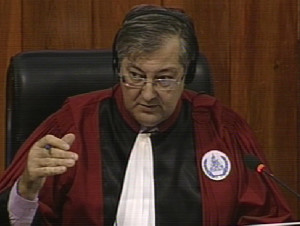
Judge Jean-Marc Lavergne
Judge Jean-Marc Lavergne interrupted the questioning and sought more information about the maps that the Co-Prosecution had requested to be admitted. Mr. Smith explained that it was not clear in some cases whether where they conducted research: his plan was to take the experts to the page where they state that they conducted their research and highlight this on the map. They had requested one map to be admitted without any annotations.
At this point, the President adjourned the hearing for a break.
Marriages prior to the Khmer Rouge
After the break, Judge Fenz ruled on the Co-Prosecution’s request. The map was admitted without annotations. The Chamber permitted the annotated maps during the time of the expert’s testimony. A request would have to be made to admit these into evidence.
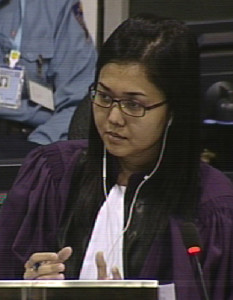
National Deputy Co-Prosecutor Song Chorvoin
Deputy National Co-Prosecutor Song Chorvoin sought information about marriages before the Khmer Rouge and wanted to know whether parents of both sides were present at the weddings. Ms. Nakagawa replied that she did not have accounts on the French colonial time, and only from the 1960s onwards. She explained that marriages in this time were arranged by parents and agreed upon by both sides. The daughters had decision power that “was almost zero”. Boys, in contrast, had more decision power and could propose this to his parents. If the parents disagreed, it was “extremely difficult” for that person to marry the girl they liked. After the approval of both parents, a wedding date would be set – sometimes with the help of a fortune teller. The ceremony would usually last three days and Buddhist would participate. “So it’s not a personal matter, but a family matter […]. And also it’s a communal matter”. Since the war before the Khmer Rouge toughened life, the ceremonies were simplified and held within a day. This was the case around three or four years before the Khmer Rouge.
The village chief was invited to attend the ceremony to authorize the marriage. If a girl had lost her parents during the war, other relatives – such as siblings – would decide upon the matter. The girl had no say in this. The boy could make proposals as to who to marry. Traditionally, children were not seen as having “proper rights”, which was why parents thought that they had to make decisions regarding everything in the children’s lives.
One woman had refused to get married before the Khmer Rouge, but was forced to marry under the Khmer Rouge. She wanted to become a medical doctor and studied at a university for this. She refused to marry the proposed groom and her younger sister had to marry this man. She could not recall any case in which a boy or girl was sanctioned or punished when refusing to marry someone before the Khmer Rouge.
Ms. Chorvoin quoted Ebihara, who had said that “When the latter receives a marriage proposal, the young woman herself is consulted and, again according to tradition, is free to accept or reject the offer” and that “In summary, traditional weddings previous to the Khmer Rouge held extraordinary significance for couples, families, and whole communities – including ancestral spirits. They were largely arranged, most often with the consent of [the spouses].”[3]
Ms. Nakagawa agreed with this, but said that the woman would be consulted, but that the woman had no choice in marrying: “I don’t think that it was a genuine consent”. It depended on the parents as to how much information they gave to their children. Often they met their husband for the first time at the wedding. However, they did not regard themselves as unfortunate according to her research: “They are happy to accept and follow the decision by their parents”. It was, to her view, “One hundred percent family matter”. The authorities were informed after everything had been arranged. She could not recall any marriages that were arranged in a short manner. The arrangements could last a few months or half a year. In 1973 and 1974, however, some parents were worried about the security of their daughters and rushed them into marriage. This took only place in some areas and not in the whole country.
“The marriages under the Khmer Rouge were completely different from the traditional marriages”. The traditional marriage should include the participation of the family members, which was missing under the Khmer Rouge time.
As for social status, Ms. Nakagawa recounted that marriages before the Khmer Rouge were primarily family matters. “It’d be very difficult to match a girl from a completely different social background to marry a man who is living in another man”. Thus, farmers married farmers, educated married educated people.
Ms. Chorvoin then asked about the attendance of family members. Ms. Nakagawa explained that family members, villagers (such as neighbors) and local authorities were expected to join. As for divorces, it was “extremely shameful” to divorce. Men could simply keep several wives. It was possible to divorce and she knew cases where this happened, but she said that it “must have been an extremely tough decision”. Parents would not tell their daughters or sons how to behave in the night of the wedding. She remembered one woman who was told to be obedient to her husband during the night of the wedding. In Cambodian society, sexuality was not spoken about openly. Nevertheless, parents would ask whether they were expecting children. She did not recall any account that parents made explicit instructions to their children before the Khmer Rouge that they should have a child to keep the family line. “But I may be wrong”. She did not think that parents would instruct their children. However, there was a social pressure that still existed nowadays that they should have children after marriage. The consummation of marriage was very personal, which was why parents would not instruct them about this matter. She had met one women who did not consummate the marriage for around three or four months, because she and her husband were both very shy. “And this was just fine”. At this point, Ms. Chorvoin handed the floor to her colleague William Smith.
Marriages during the Khmer Rouge
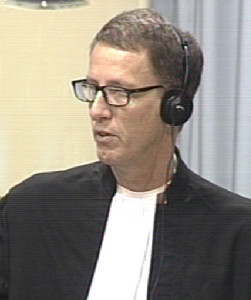
Nuon Chea Defense Counsel Victor Koppe
Mr. Smith asked about differences between marriages prior and during the Khmer Rouge.[4] She explained that the authority lay solely with the Khmer Rouge during Democratic Kampuchea, while it was a family matter before this. When Mr. Smith asked about marriages under the Khmer Rouge, Nuon Chea Defense Counsel Victor Koppe objected and said that the term Khmer Rouge was too generic for an expert testimony. The Co-Prosecutor needed to be more specific.
Before the Khmer Rouge time, the couples did not have to ask for permission from the local authorities. This was different during the Khmer Rouge: they had to seek approval by the Khmer Rouge. Sometimes the procedure was similar: the parents of both parties had to agree and sought permission by the Khmer Rouge. Sometimes individual women would approach the Khmer Rouge. The decision-making process was done on the village-level. Some authorities did not allow marriages between a couple that is too young. Some other authorities, such as the ones in Kampong Cham, did not authorize marriages until later.
One of the main driving factor for women was that the Khmer Rouge allowed injured Khmer Rouge soldiers to select their wives. To her knowledge, this was nation-wide. “So many single young women were very scared if they were selected”. They had to marry handicapped soldiers. “Any married woman could stay close to their parents” was one of the privileges that they believed to have. “Many believed that the status as a wife would reduce the burden of work”. She did not know what drove men to apply for marriages.
To her knowledge, women had to follow decisions for marriages “without any questioning”.[5] Mr. Smith read out an excerpt of her book, in which a young soldier had talked about marriages.[6] She answered that this was a rare occasion that a man consulted a woman before marrying. Mr. Smith asked about the hoped-for improvement of living conditions. She explained that most unmarried women were in the mobile units. They often had to wake up at 2 or 3 am. “Their lives were miserable”. They believed that they would not be in this group when being married. Mr. Smith wanted to know whether she asked them directly whether they only married because of the living conditions imposed on them. “They were not waiting for the Khmer Rouge to approach them. They were willing to marry”.
Ceremonies
There were mass ceremonies with at least two or three couples attending the ceremony at least. The ceremony was very short and every couple was required to make an oath that they were voluntarily married for Angkar. “I would assume that [the ceremony lasted] maximum an hour”. If there were 100 couples, there would be a representative making the oath. It was uncommon that parents attended the ceremonies. It was also “very very rare” that rituals were taking place. “It was more like a meeting”. The newly-wed couples were allowed to stay in a hut for a few days up to a week. They had to work during the day.
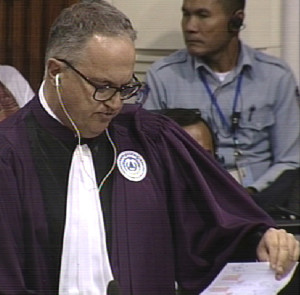
International Deputy Co-Prosecutor William Smith
Mr. Smith asked whether the approach she had taken was a victim-based approach in contrast to analyzing contemporaneous documents or speeches of policy leaders. She confirmed this.
Forced marriage took place regardless of age or social status. She called it forced marriage when a person did not want to marry. She explained that she was looking at individuals, so she could determine individually whether they were forced to marry. Her impression was that the marriages were mixed. In late 1977 and 1978, many mass weddings were organized amongst forced-marriage-couples. Both men and women were informed early in the morning or the afternoon before that they were going to marry. The marriage was conducted in the evening.
Mr. Smith quoted an excerpt of a woman’s account of her wedding:
“I was forced to marry a man who lived in another village. I never knew him before the marriage. I felt so bad, and I really did not want to marry him […] my parents were not there with me. The only people present were those who were going to marry, so there were hundreds of men and women who had never seen nor known each other before. […] Suddenly a KR leader of the male group ordered those men in the room to choose any woman who they wanted to have as a partner. One man pointed at me, and the KR soldier instructed us to make an oath for Angkar by saying that we were marrying. […] No one could refuse the marriage order. If anyone refused, they would be killed.” [7]
Mr. Smith asked whether this was a typical situation. She said that it was common, but that usually partners were decided upon earlier. She confirmed that this meant that the Khmer Rouge had already chosen the couples to be married. The largest number she had heard of were 300. Mostly, the ceremonies included less than 50 couples. The typical marriage was two to eight couples per day. There were some possibilities of refusing, but this was rare. She heard about these possibilities everywhere she went to.
Mr. Smith read an excerpt of her book, in which an account was quoted of a woman who married a man, because she was threatened.[8] Mr. Smith asked whether wanted to know whether this was a common pattern. She explained that “people were already terrified. They lived under extreme fear. […] There was a silent pressure in the society where they should not say no”.
She heard of a woman witnessing a rape, because she refused to marry. Mr. Smith asked about an incident in which a woman was raped and asked them to kill her.[9] Ms. Nakagawa could not remember this, but explained that two researchers had interviewed women. One woman had told her that she was sent to a re-education camp, because she refused to get married. In some areas, “the village chiefs were sympathetic and very nice”. Under those conditions, people dared to refuse the proposals. In areas where the Khmer Rouge imposed a strict policy, people did not dare to refuse. This feeling of fear different from different regions and individual to individual. “But it was reported from all the areas that I visited that women lived under terror, under continuous terror.”
Those people who were forced to marry against their will, they were given a hut where they were instructed to stay together. “And mostly they were instructed to consummate their marriage”. Both men and women “said that they did not want to and had to for their survival”. She said that it was difficult to evaluate situations in which men used violence on women.[10] Many men were also scared and used violence, because they felt forced to consummate the marriage. Some men were scared and could not consummate the marriage. Moreover, some men had an image of masculinity that they had to show strength.
Pregnancy
Mr. Smith then inquired whether she came across women who wanted to abort children. She said that the women she met, in principle, did not want to get pregnant during this time. There was no difference in this regard between those who voluntarily married and those who were forced to marry. However, those women who were forced to marry and became pregnant suffered from worse depression. Women did not necessarily talk openly with her about the topic of abortion, because this was a taboo-topic.[11] However, many explicitly said that they thought about abortion.
Divorce
“Many women said that they stayed together with their husbands […] because their husbands brought food”. This was a stereotypical gender role, in which men were expected to protect and support their wives. Those who were separated already, “they regret that the marriage happened at all”. Those who continued their marriage, they “may not deny all the journeys that they traveled together”. The consent to the forced marriage “was of course not their own free will and the decision to sexuality was also not their own. They were terrified and they were scared.”
At this point, the President adjourned the hearing for a break.
Policy
Mr. Smith asked whether forced marriages occurring in Democratic Kampuchea in most provinces, which the expert confirmed. “I think there was a policy from top-level to organize levels, but I don’t have enough evidence to say that there was a policy from top-level to organize forced marriages”.[12] Mr. Smith then confronted the expert with the book by Thet Sambath and Gina Chorn, in which they had quoted Nuon Chea saying that men always wanted to marry beautiful women.[13] Mr. Koppe objected and said that this went beyond the expert’s knowledge and that the selection of the contemporaneous document was too selective. The objection was not sustained. Mr. Smith then read out the 6th Revolutionary Principle (do not violate women, and men, woman and collective have to agree to a marriage) and wanted to know whether this was reflected in the practice she knew.[14] She answered that some people who were forced to marry were forced to make an oath that they agreed, so it was not their voluntary decision. As for the collective, no one could object to the wedding of someone else. The men and women could not always disagree to marriages.
Safety net
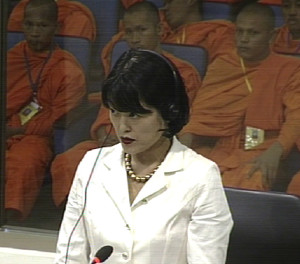
Expert Kasumi Nakagawa
The floor was granted to the International Civil Party Lead Co-Lawyer Marie Guiraud. Ms. Guiraud inquired whether marriages before the Democratic Kampuchea regime were important in the life of Cambodians. Ms. Nakagawa said that the importance was that women had to fulfill the duties as daughters to follow their parents’ decisions and to pay respect and gratitude to their parents. Thus, it was a very important symbolic process. For men, it was an important step to establish their hegemonic masculinity to provide care to someone away from their parents. Ms. Guiraud asked about a “safety net” that an author had said had disappeared during the Khmer Rouge time.[15] Ms. Nakagawa agreed with this. Husbands and wives were removed from their parents and husbands and wives separated themselves. “So there was no safety net”. Young single women lost the protection from their parents and the opportunity to provide protection to their parents. “The emotional impact from such should have been huge that daughters could not protect their parents”. The younger men needed protection of their families and missed their mothers. She had been repeatedly told that the men were missing their mothers. She did not think, however, that men felt the same need to protect their parents as women did.
Before the Democratic Kampuchea period, the parents of both parties engaged actively more than their sons or daughters. [16] One woman recounted that her father could not attend her wedding for half of it, since he had a government meeting. “The simple participation to the wedding […] showing the acceptance of the [arrangement] […] I think that is already called blessing”. The absence of their parents was an important negative factor. “They still carry on this legacy or remorse until now”, she said.
She did not recall any impact of missing any religious ceremony. “It’s more about the absence of their parents and their family members, and they wanted to community people to also celebrate, but it was not possible. And also the clothing that they were forced to wear the black clothing”. The food was different as well.
Ms. Guiraud then quoted a proverb regarding the virginity of Cambodian women.[17] Ms. Nakagawa said that it was not a physical issue but a symbolic meaning. Some women regretted losing their virginity as a consequence of their marriage. There were many accounts of men and women who were forced to marry under the Khmer Rouge.[18] In the evening, most probably small children were sent by the Khmer Rouge to spy on the couples and whether they consummated their marriage. It “extremely and disproportionately affected on men, because men were forced and tasked to rape their wives”. “The fear was immeasurable if he failed to do it”. Many women showed that they were not ready to accept their women. “It’s an inhuman act. And I could not imagine how some men could have done that”. She said that “maybe some men were sent to re-education for failing to rape the wife”. This impacted on the marriage as well, since the husband might be tormented by guilt.
She gave the example of a woman who was “already deprived of almost all hope”. They knew what would happen in the evening. On the one hand, she had to accept the husband “because it is an absolute order”. Some rapes were “not violent”. “A loss of parental consent to the marriage was a big traumatic event”. Another step to “put her into another traumatic experience” was to force her to consent to having intercourse. In her view, this was legalized rape. Both men and women “were living under the multiple layers of terror and horrors”. They were subject to multiple human rights violations, including rape, she said.
Some women were forced to marry a man she did not want to marry by her parents. When there was no parental consent, she was not obliged to love or feel affection for the men. When the women got pregnant, many of them “got angry”, because they could not escape. If she cannot have affection to the child, “how can the child survive?” And “if a child was born, can she love the child that was born outside parental consent?”
The President adjourned the hearing. It will continue tomorrow, at 9 am with the testimony of expert Kasumi Nakagawa.
[1] E319/59
[2] E319/52.
[3] E3/9614, at 01212343 (KH), no translation. 01 40 (EN)
[4] E3/10655, at 01322862 (EN).
[5] E3/2959, at 00421894-05 (EN), 00738350 (KH), 00701497 (FR).
[6] E3/2959, at 00421894 (EN), 00738349 (KH), 00701497 (FR).
[7] p. 277. E3/10655, at 01322865 (EN).
[8] E3/10655, at 01322864 (EN).
[9] E3/2959, at 00421893 (EN), 00738347-48 (KH), 00701496 (FR).
[10] At 00421892 (EN), 00738345 (KH) , 00701495 (FR), p. 89.
[11] Page 289.
[12] E3/3416, at 00449489 (EN), 00721382 (KH), 00630485 (FR).
[13] E3/775, at 00417943 (EN), 00407101 (KH), 00593930 (FR). E3/4202, at 00858253 (KH), 00849377-78 (FR).
[14] E3/765, at 00539994 (EN), 00376493-97 (KH), 00540024-25 (FR).
[15] E3/9614, at 01037063 (EN).
[16] 2-TCCP-232, 25 August 2016.
[17] E3/2959, at 00421889 (EN).
[18] E3/2959, at 00421892 (EN), 00738345 (KH).
Featured Image: Expert Kasumi Nakagawa (ECCC: Flickr).
